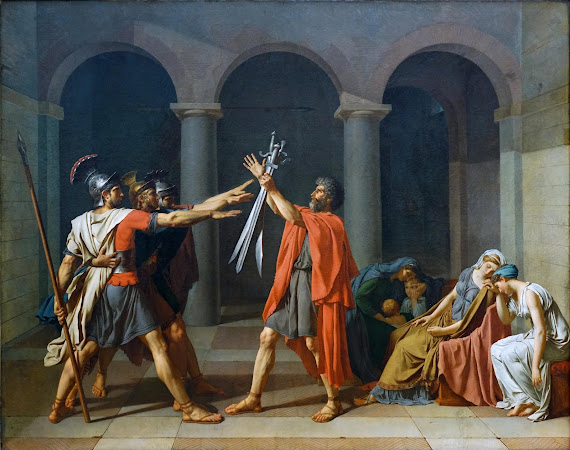Baroque
 |
| "The Calling of Saint Matthew" by Caravaggio 1599-1600 |
"As Jesus went on from there, he saw a man named Matthew sitting at the tax collecter's booth. "Follow me," he told him, and Matthew got up and followed him."
Once you hear or understand this verse, the painting becomes much clearer and becomes more meaningful. Caravaggio puts the tiniest details into this piece which are truly the most influential part and can get lost if you're not paying attention. The main figures, Christ and Matthew, are almost hidden inside the silent yet dramatic scene. Christ stands behind St. Peter to where he's barely noticeable, but Caravaggio uses the contrast of light and dark to expose (or highlight) a part of Christ's hand and face. Furthermore, Caravaggio expresses the barest hint of the divine in the hairline halo above Christ's head.
You could definitely pick out Christ if you were unfamiliar with the Bible. However, it becomes more difficult to depict which figure is St. Matthew if you weren't familiar with scripture. In Matthew 9:9, Christ is calling upon Matthew to become his disciple and we can see this being depicted as Christ points at Matthew and Matthew points to himself as well in question. Almost as if Matthew is silently asking "me??" -which I would totally do as well if Jesus called me to follow him.
Both Christ and Matthew are identified by light and gesture (their pointing). We can see there is light streaming in from an unknown source- perhaps a second window- which pours in from Christ's head to Matthew's face. Caravaggio's intense naturalism creates such a beautiful and sharp contrast of light and shadow that it almost feels like we could jump into this piece and live inside the scene. If you've read my blog before, you know I talk about the Bible a lot, so yes, I would absolutely have this piece in my home!
Caravaggio's The Calling of Saint Matthew was obviously influenced by the church, but I also believe there is some influence from the rise of the merchant classes. It may be a little bit of a stretch but bear with me here. The rise of merchant classes created more growth within society and their economy, "merchants were the elite class of many towns and controlled the town government" (Tusker). In The Calling of Saint Matthew, Caravaggio dresses Matthew and the other men in elite contemporary clothing, and they are shown sitting at a tax collector's booth counting money. We can infer that Matthew is a tax collector, which is technically a kind of merchant. Even though this is not the main focus of the painting, the rise of the merchant class could have been an influence for Caravaggio.
Work Cited.
Benaven, J. “Baroque: The Calling of St. Matthew.” JBENAVENTEBLOG, 18 Feb. 2016, jbenaventeblog.wordpress.com/2016/02/18/baroque-the-calling-of-st-matthew/.
Camara, Dr. Esperança. “Baroque Art in Europe, an Introduction.” Khan Academy, www.khanacademy.org/humanities/renaissance-reformation/baroque-art1/beginners-guide-baroque1/a/baroque-art-in-europe-an-introduction.
“Caravaggio, Calling of Saint Matthew.” Translated by Dr. Steven Zucker and Dr. Beth Harris, Khan Academy, www.khanacademy.org/humanities/renaissance-reformation/baroque-art1/baroque-italy/v/caravaggios-calling-of-saint-matthew.
“The Rise of the Merchant Class.” Tusker Geografica, https://www.tusker.com/Geografica/working-for-a-living/.




That really is a perfect recreation of that passage. I'm not Bible literate but the way you explain it makes sense. It seems like the only reason Christ is so well lit is because his surroundings are very dark. I'm not really sure about tax collectors being a form of merchant though. It's definitely an agruable point, but the core of a merchant is trading right? Tax collectors don't really trade I feel. That said, I can absolutely get behind with it being influenced by the Church. I think you chose a good piece.
ReplyDeleteThis is an incredible piece. I enjoy how you emphasized the chiaroscuro, and how it highlights the distinctive features of Christ. The "hairline halo" really is barely noticeable! I think the tax collectors' connection to the merchant class is a bit interesting. I think that there is a bigger connection to how Caravaggio and Baroque artists were funded by the merchant class. Also, there is another painting by Bartolomeo Manfredi, Christ Driving the Merchants from the Temple, that this piece reminds me of. Manfredi was a follower of Caravaggio! The themes of Christianity seemed to extend beyond Caravaggio and onto his followers.
ReplyDeleteI absolutely enjoyed viewing this art work that you shared! I really enjoyed reading your explanation of the piece and how it had been influenced by the church which I definitely can see. Caravaggio was an amazing artist with his works of chiaroscuros. The thing that interested me the most about your post was how you concluded that Matthew was a tax collector and a merchant. Which although I think there is a bit of a difference between a tax collector and a merchant I see what you mean. As well as how this all goes to show merchant class influence on Caravaggio. Great post!
ReplyDelete